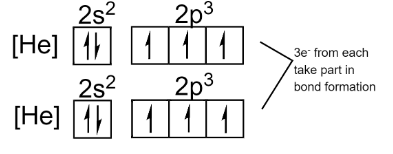
The electronic configuration of nitrogen is 2, 5. How many electrons in the outer shell of the nitrogen atom are not involved in the formation of a nitrogen molecule?
Answer
448.8k+ views
Hint: While the formation of the nitrogen molecule, each nitrogen atom is deficient of 3 electrons to complete their octet. So, each atom will share 3 electrons to form the bond and the rest of the electrons will not be involved in bond formation.
Complete step by step solution: The nitrogen belongs to group 15 of the periodic table and its electronic configuration is –
We can see that the inner 1s – orbital is fully filled, so it will not take place in bonding. The outermost orbital of nitrogen contains a total of 5 electrons
Now, when two atoms of nitrogen approach each other, they both equally share three electrons each and form a triple covalent bond to complete their octet as shown below.

The electronic configuration of the system will look like this:

Thus, we can see that out of 5 valence electrons only 3 are involved in the bonding during the formation of a nitrogen molecule. So, the remaining 2 electrons remain intact in each nitrogen atom.
Hence, two electrons in the outer shell of each nitrogen atom are not involved in the formation of a nitrogen molecule.
Note: The nitrogen forms a covalent bond with another nitrogen atom by sharing its 3 valence electrons. It cannot completely accept or donate electrons to form an ionic bond due to the presence of stable half-filled p-orbital in its valence shell.
Complete step by step solution: The nitrogen belongs to group 15 of the periodic table and its electronic configuration is –
We can see that the inner 1s – orbital is fully filled, so it will not take place in bonding. The outermost orbital of nitrogen contains a total of 5 electrons
Now, when two atoms of nitrogen approach each other, they both equally share three electrons each and form a triple covalent bond to complete their octet as shown below.

The electronic configuration of the system will look like this:

Thus, we can see that out of 5 valence electrons only 3 are involved in the bonding during the formation of a nitrogen molecule. So, the remaining 2 electrons remain intact in each nitrogen atom.
Hence, two electrons in the outer shell of each nitrogen atom are not involved in the formation of a nitrogen molecule.
Note: The nitrogen forms a covalent bond with another nitrogen atom by sharing its 3 valence electrons. It cannot completely accept or donate electrons to form an ionic bond due to the presence of stable half-filled p-orbital in its valence shell.
Recently Updated Pages
Master Class 11 Business Studies: Engaging Questions & Answers for Success

Master Class 11 Accountancy: Engaging Questions & Answers for Success

Master Class 11 Computer Science: Engaging Questions & Answers for Success

Master Class 11 English: Engaging Questions & Answers for Success

Master Class 11 Social Science: Engaging Questions & Answers for Success

Master Class 11 Economics: Engaging Questions & Answers for Success

Trending doubts
Which one is a true fish A Jellyfish B Starfish C Dogfish class 11 biology CBSE

State and prove Bernoullis theorem class 11 physics CBSE

1 ton equals to A 100 kg B 1000 kg C 10 kg D 10000 class 11 physics CBSE

In which part of the body the blood is purified oxygenation class 11 biology CBSE

One Metric ton is equal to kg A 10000 B 1000 C 100 class 11 physics CBSE

Difference Between Prokaryotic Cells and Eukaryotic Cells




